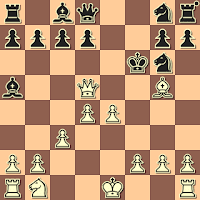I recently received an email from "Cliff Hardy" that contained a significant "reveal" as well as an entertaining Jerome Gambit game. The following notes are his, except for some minor ones by me, in blue. Enjoy!
An epiphany on Epiphany OR Batman* vs the "Visual Bat"
Hi Rick,
I had an epiphany on Epiphany!
The epiphany was to play the Jerome Gambit on the 6th of January, the date of Epiphany - the day of the year dedicated to the Christian feast celebrating the manifestation of the divine nature of Jesus to the Gentiles, as represented by the Wise Men.
I don't really mind whether I am referred to as my Bruce Wayne-like name of Kevin Sheldrick or my Batman-like alter ego "Cliff Hardy", since I now have played a Jerome Gambit in a tournament game and have been told by the arbiters that all games from this tournament will be published on the internetski at some point - in other words, my secret identity is out!
All analysis below is with Stockfish.
Sheldrick, Kevin - Bhat, Vishal
Australian Open, 2017
1.e4 e5 2.Nf3 Nc6 3.Bc4 Bc5
I now spent about a minute on my fourth move and found it extraordinarily difficult to play my planned 4.Bxf7+. This hesitation largely being due to a battle raging inside of me of conflicting thoughts of doubt and fear of playing the Jerome, giving rise to a soliloquy, going something like this:
Me (to my brain): "This is one of the most prestigious chess tournaments in Australia - don't take on f7!"
4.Bxf7+
My brain (to me): "DON'T TELL ME WHAT TO DO!"
4...Kxf7 5.Nxe5+
Surprisingly, this move was, by now, very easy for me to physically play. I guess it's kind of like trying to go into a cold swimming pool. At first you may be terrified to even dip your toe into it, but if you can put aside the fear and just jump in, you can then adjust to it rather easily.
5...Nxe5 6.Qh5+
Fellow participant, Tony Fereday, in the post-mortem exclaimed, around this point in the game, "I wonder what he was thinking!", in reference to my opponent.
6...Ng6?!
Better 6...Ke6
7.Qd5+ Ke8 8.Qxc5 d6 9.Qe3 Nf6
This position is as old - fittingly - as Charlick - Mann, correspondence, Australia, 1881 (1-0, 72). The Database has 163 games with the position, with White scoring 70%. Mind you, beside this one, only one other game (by Guido de Bouver of Flanders, Belgium) is an over-the-board encounter. - Rick
10.O-O Ng4
Better 10...Kf7
11.Qg3 h5?!
Better 11...Nf6
12.h3?!
12.d4 is best, which would allow the bishop on c1 to cover f4 and prevent the knight on g6 from going there, where it may assist black to launch a kingside attack.
12...h4 13.Qb3
Having made queen moves for almost half of the total moves played (6 out of 13 moves), it was apparent that I had been violating a few established chess opening principles so far in the game.
13...Nf4!
A brilliant sacrifice!
An improvement over the play of the only other game in The Database to reach this position: 13...N4e5 14.f4 Nc6 15.Nc3 Qf6 16.d3 Qd4+ 17.Kh1 Nf8 18.Nd5 Kd8 Black resigned, perrypawnpusher - Riversider, FICS, 2010 - Rick
14.hxg4??
Oops! The cautious 14.Kh1! may help white to hope to defend against the vicious black assault on the white king.
14...h3?
A miscalculation in a bafflingly complex position - 14...Qg5! actually leads to a thumping black kingside attack e.g. 15.f3 h3 16.g3 h2+ 17.Kh1 Ne2.
15.g3 h2+ 16.Kh1 Bxg4 17.gxf4
White has defended well, and is a pawn and a piece ahead. Things are still scary for him, but Black has only one move to keep the advantage. - Rick
17...Bh3?!
An inaccuracy - 17...Qh4! 18.f3 Bh3
18.Re1 Qh4 19.Qg3 Qh5 20.d4 Black resigned
Eerily, as I went strolling in the moonlight one night (I think it
was the night immediately after I had just played this game), a large visual bat (or flying fox, as they are referred to in Brisbane) emerged from a nearby tree above my head and flew away, silhouetted magestically against the night sky but, oddly, I didn't fully comprehend the ominousness of that until days
later.
The final position is still quite complicated, but White should be okay. If need be, he can return some material to settle things down further (i.e. Re3 with the idea of sacrificing the exchange on h3 while exchanging Queens) - and he always has his "Jerome pawns"! Black may have realized at this point that he could save his energy for the next round.
However dubious the honor, Kevin seems to have grasped the title of "strongest player to use the Jerome Gambit in serious over-the-board play". Well done! - Rick











































